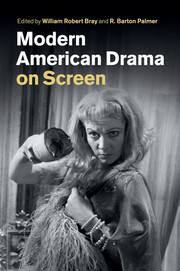Book contents
- Modern American Drama on Screen
- Modern American Drama on Screen
- Copyright page
- Contents
- Illustrations
- Notes on contributors
- Introduction
- Chapter 1 Realism, censorship, and the social promise of Dead End
- Chapter 2 Filming Our Town (1940) or the problem of “looking at everything hard enough”
- Chapter 3 Screening Death of a Salesman: Arthur Miller’s cinema and its discontents
- Chapter 4 Elia Kazan’s A Streetcar Named Desire
- Chapter 5 Come back, little scopophile: William Inge, Daniel Mann, and cinematic voyeurism
- Chapter 6 The Big Knife: Hollywood’s “fable about moral values and success,” a movie about the movies
- Chapter 7 Adapting Lorraine Hansberry’s sociological imagination: race, housing, and health in A Raisin in the Sun
- Chapter 8 Double vision: the film adaptations of The Children’s Hour
- Chapter 9 Sidney Lumet’s family epic: re-imagining Long Day’s Journey into Night
- Chapter 10 Hollywood's Who's Afraid of Virginia Woolf?: breaking the code
- Chapter 11 Sex, lies, and independent film: realism and reality in Sam Shepard’s Fool for Love
- Chapter 12 Actor, image, action: Anthony Drazan’s Hurlyburly (1998)
- Chapter 13 David Mamet brings film to Oleanna
- Chapter 14 To what end a cinematic Wit?
- Chapter 15 Theatrical, cinematic, and domestic epic in Tony Kushner’s Angels in America
- Filmography
- Index
Chapter 11 - Sex, lies, and independent film: realism and reality in Sam Shepard’s Fool for Love
Published online by Cambridge University Press: 05 September 2013
- Modern American Drama on Screen
- Modern American Drama on Screen
- Copyright page
- Contents
- Illustrations
- Notes on contributors
- Introduction
- Chapter 1 Realism, censorship, and the social promise of Dead End
- Chapter 2 Filming Our Town (1940) or the problem of “looking at everything hard enough”
- Chapter 3 Screening Death of a Salesman: Arthur Miller’s cinema and its discontents
- Chapter 4 Elia Kazan’s A Streetcar Named Desire
- Chapter 5 Come back, little scopophile: William Inge, Daniel Mann, and cinematic voyeurism
- Chapter 6 The Big Knife: Hollywood’s “fable about moral values and success,” a movie about the movies
- Chapter 7 Adapting Lorraine Hansberry’s sociological imagination: race, housing, and health in A Raisin in the Sun
- Chapter 8 Double vision: the film adaptations of The Children’s Hour
- Chapter 9 Sidney Lumet’s family epic: re-imagining Long Day’s Journey into Night
- Chapter 10 Hollywood's Who's Afraid of Virginia Woolf?: breaking the code
- Chapter 11 Sex, lies, and independent film: realism and reality in Sam Shepard’s Fool for Love
- Chapter 12 Actor, image, action: Anthony Drazan’s Hurlyburly (1998)
- Chapter 13 David Mamet brings film to Oleanna
- Chapter 14 To what end a cinematic Wit?
- Chapter 15 Theatrical, cinematic, and domestic epic in Tony Kushner’s Angels in America
- Filmography
- Index
- Type
- Chapter
- Information
- Modern American Drama on Screen , pp. 203 - 219Publisher: Cambridge University PressPrint publication year: 2013

